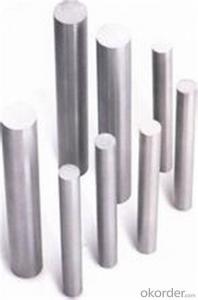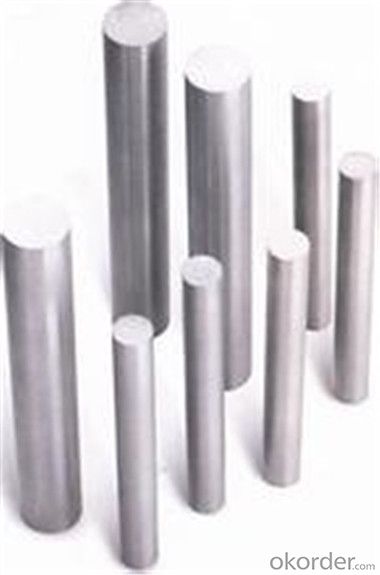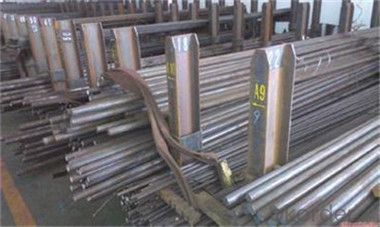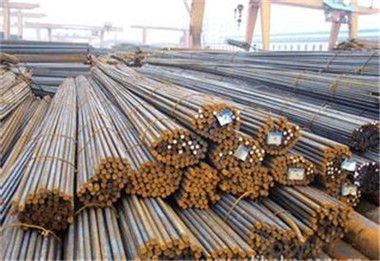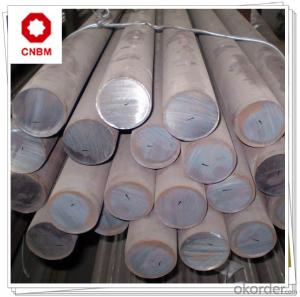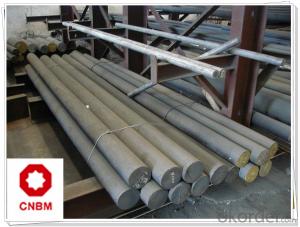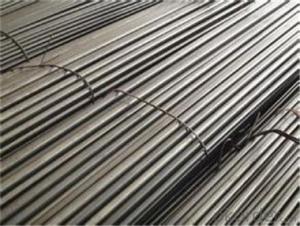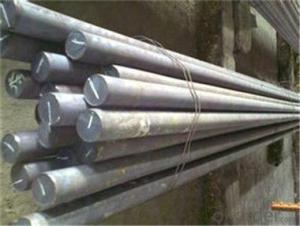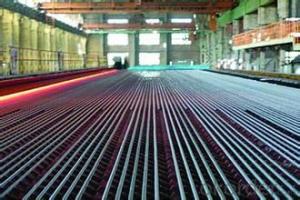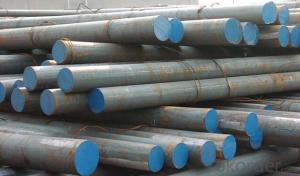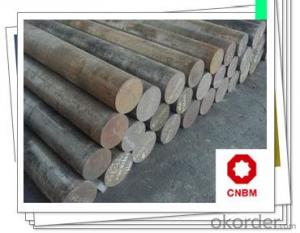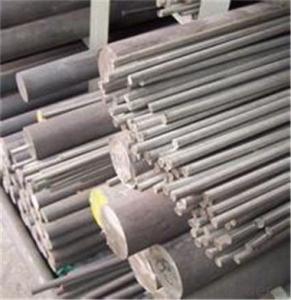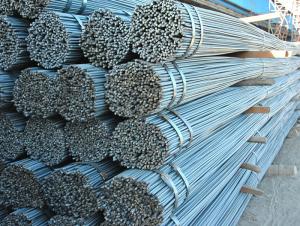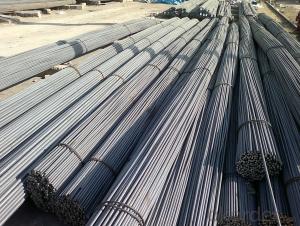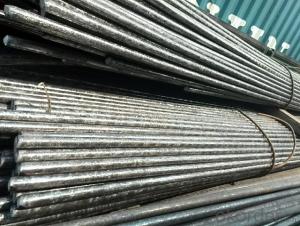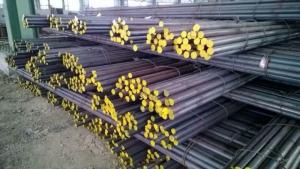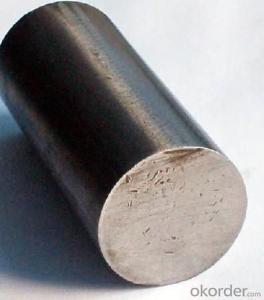GB1499.2 TOP A36 Steel Round Bars Free Cutting from China
- Loading Port:
- Shanghai
- Payment Terms:
- TT OR LC
- Min Order Qty:
- 44 m.t.
- Supply Capability:
- 2000000 m.t./month
OKorder Service Pledge
OKorder Financial Service
You Might Also Like
Specification
Description of steel round bar:
Cold Drawn Round Bar
1.Diameter:4mm-120mm
2. Lengh:According to customers' requirements
Festures of steel round bar:
4340 Forged Round Steel Bar
1.Dia 80-800mm Length:2000-13000mm or as required
2.Technique:Forged
3.Delivery Time:45 days
Specifications of steel round bar:
1. Standards: AISI 4340 8620 8640 4320 , JIS SNCM8 GB:40CrNiMoA
2. Specification: Dia: 80~450mm Length:2000-13000mm or as required
3. Chemical Composition (%):
C | Si | Mn | S | P | Cr | Ni | Cu | Mo |
0.37-0.44 | 0.17-0.37 | 0.40-0.80 | 0.025(max) | 0.025(max) | 0.60-0.90 | 1.25-1.65 | 0.025(max) | 0.15-0.25 |
Images of steel round bar:

FAQ:
1. What is your package?
Packing situation: standard seaworthy packing or as customer required.
2. How long is the lead time?
Delivery time: 45 days after order confirmed.
3. What payment term do you accept?
Payment: T/T or L/C at sight.
- Q: What are the different grades of tool steel round bars?
- Various grades of tool steel round bars are offered, each possessing unique properties and characteristics tailored to specific applications. Examples of these grades include: 1. W1: With its relatively low carbon content, W1 is a water-hardening tool steel renowned for its exceptional toughness and good wear resistance. It finds common usage in cutting tools and woodworking tools. 2. O1: O1 tool steel round bars are oil-hardening tool steel boasting high carbon content. They exhibit excellent wear resistance, high toughness, and exceptional dimensional stability. O1 tool steel is frequently employed for punches, dies, and cutting tools. 3. A2: A2 tool steel round bars are air-hardening tool steel with moderate carbon and chromium content. They offer good wear resistance, superior toughness, and high dimensional stability. A2 tool steel is a popular choice for blanking and forming dies, as well as shear blades. 4. D2: D2 tool steel round bars are characterized by their high carbon and chromium content, providing outstanding wear resistance and good toughness. They exhibit remarkable resistance to abrasive wear and are commonly utilized in the production of cutting tools, punches, and forming dies. 5. M2: High-speed M2 tool steel round bars are enriched with a notable amount of tungsten, molybdenum, and vanadium. They deliver exceptional wear resistance, high red hardness, and good toughness. M2 tool steel is typically employed for high-speed cutting tools, drill bits, and machining tools. 6. S7: S7 tool steel round bars are air-hardening shock-resistant tool steel. They possess high impact toughness, good wear resistance, and excellent heat resistance. S7 tool steel is frequently applied in applications necessitating high shock resistance, such as chisels and hammers. These are merely a few instances of the diverse grades of tool steel round bars available in the market. The choice of grade hinges on factors such as the specific application, desired hardness, wear resistance, toughness, and heat resistance required. It is crucial to seek guidance from a knowledgeable supplier or metallurgist to ascertain the most appropriate grade for a given application.
- Q: What is the difference between a centerless ground and a rough turned steel round bar?
- The manufacturing processes and resulting surface finishes of a centerless ground steel round bar and a rough turned steel round bar differ. To produce a centerless ground steel round bar, the bar is fed through a grinding machine. This machine removes material from the surface, achieving precise diameter and roundness tolerances. The bar is rotated between two grinding wheels, while pressure is applied to remove imperfections and create a smooth, polished surface. The end result is a highly accurate and consistent diameter, with a mirror-like finish. This makes it suitable for applications that require tight tolerances and a polished appearance. On the other hand, a rough turned steel round bar is manufactured using a different machining process called turning. In this process, the bar is rotated against a cutting tool, which removes material from the surface to achieve the desired diameter and shape. However, turning does not provide the same level of precision and surface finish as centerless grinding. The resulting surface of a rough turned bar will have visible tool marks and a rougher texture compared to a centerless ground bar. In conclusion, the main distinction between a centerless ground steel round bar and a rough turned steel round bar lies in their manufacturing processes and resulting surface finishes. Centerless grinding offers a more precise diameter, roundness, and smoother surface finish, making it ideal for applications that require tight tolerances and a polished appearance. Rough turning, while less precise and with a rougher surface finish, is still suitable for applications that do not require the same level of precision or aesthetic appeal.
- Q: What are the different alloying elements used in steel round bars?
- The different alloying elements commonly used in steel round bars include carbon, manganese, silicon, sulfur, phosphorus, chromium, nickel, molybdenum, vanadium, and sometimes tungsten. These elements are added in varying quantities to enhance specific properties of the steel, such as strength, corrosion resistance, and heat resistance.
- Q: What is the difference between 40Cr round steel and 40Cr steel forgings?
- The casting process constructed a fine grain structure and improved the physical properties of the metal. The utility model has the advantages of high strength and good plasticity, and is suitable for making important parts with large force and high requirement.The properties of forgings are superior to those of ordinary ones.
- Q: How can a round steel weld on a flat steel plate be flat and qualified?
- It is required that the current is suitable and the bar is stable. If required, the groove can be turned on the round steel to ensure that the welding is beautiful and qualified
- Q: How can steel round bars be protected against corrosion?
- Steel round bars can be protected against corrosion through various methods such as applying a protective coating, galvanizing, using corrosion inhibitors, or implementing cathodic protection. These techniques form a barrier between the steel surface and corrosive elements, preventing or slowing down the process of corrosion.
- Q: Can steel round bars be used in the production of sporting goods?
- Sporting goods can indeed utilize steel round bars. Steel, a versatile material renowned for its strength and durability, proves fitting for a wide spectrum of applications within the sporting goods industry. To illustrate, steel round bars can be employed to fabricate various components, including shafts, handles, frames, and supports for sporting equipment such as golf clubs, hockey sticks, weightlifting bars, and exercise machines. The robust tensile strength of steel ensures that these components can withstand the rigorous forces and pressures exerted during sports activities, thus affording stability and longevity to the resultant products. Additionally, steel round bars can be effortlessly machined, welded, and molded into different shapes and sizes to meet the particular requirements of each sporting good. Furthermore, steel's ability to resist corrosion renders it an ideal choice for outdoor sporting equipment that is subjected to diverse weather conditions. In summary, steel round bars are an immensely popular option in the production of sporting goods owing to their strength, durability, versatility, and capacity to endure the demands of various sports.
- Q: How do steel round bars compare to plastic round bars?
- Steel round bars and plastic round bars have several key differences that affect their performance and suitability for different applications. Strength and durability: Steel round bars are known for their exceptional strength and durability, making them ideal for applications requiring high load-bearing capacity. They can withstand heavy loads and resist deformation or breakage. On the other hand, plastic round bars are generally less strong and durable, making them more suitable for lighter applications where strength is not a primary concern. Weight: Steel round bars are significantly heavier than plastic round bars due to the difference in material density. This can be an advantage in some applications where additional weight is desired for stability or balance. Plastic round bars, on the other hand, are lighter and can be advantageous in applications where weight reduction is important, such as in aerospace or automotive industries. Corrosion resistance: Steel round bars are known for their excellent corrosion resistance, particularly when they are made from stainless steel. This makes them suitable for applications in harsh environments or exposed to moisture. Plastic round bars, however, are generally more susceptible to degradation due to exposure to UV radiation, chemicals, or extreme temperatures. Therefore, they may not be as suitable for outdoor or corrosive environments. Versatility: Steel round bars offer a wide range of options in terms of size, shape, and grade. They can be machined, welded, bent, or shaped to suit various applications. Plastic round bars also come in different shapes and sizes, but their versatility is somewhat limited compared to steel. They may not be as easily machined or welded, and their performance can be affected by temperature fluctuations. Cost: Steel round bars are generally more expensive than plastic round bars due to the higher cost of raw materials and manufacturing processes. Plastic round bars, on the other hand, are more affordable and can offer cost savings in certain applications. In summary, steel round bars offer superior strength, durability, and corrosion resistance, making them suitable for heavy-duty applications. Plastic round bars are lighter, more affordable, and can be advantageous in applications where weight reduction is important. Ultimately, the choice between steel and plastic round bars depends on the specific requirements of the application and the trade-offs between strength, weight, cost, and corrosion resistance.
- Q: What are the different types of steel round bar alloys used in aerospace applications?
- In aerospace applications, there are various steel round bar alloys that are commonly utilized. These alloys are selected based on their specific properties and characteristics that render them appropriate for use in aircraft and spacecraft components. Some of the most frequently employed alloys include: 1. 4130: This is a low-alloy steel that contains chromium and molybdenum. Its exceptional strength and toughness make it ideal for applications such as landing gear components and structural tubing. 2. 4340: This nickel-chromium-molybdenum steel is renowned for its high strength and good ductility. It is commonly applied in gears, shafts, and structural components that necessitate high strength and toughness. 3. 17-4 PH: This alloy is a precipitation-hardening stainless steel that offers a combination of high strength, corrosion resistance, and good toughness. It is often utilized in aerospace applications where both strength and corrosion resistance are crucial, such as turbine blades and structural components. 4. 15-5 PH: Another precipitation-hardening stainless steel, this alloy provides high strength and good corrosion resistance. It is commonly found in aerospace applications like landing gear components and structural parts. 5. 9310: This low-alloy steel is recognized for its high hardenability and toughness. It is frequently employed in aerospace applications that require high strength and excellent impact resistance, such as gears and shafts. These examples highlight the diverse range of steel round bar alloys utilized in aerospace applications. Each alloy possesses specific properties and characteristics that make it suitable for fulfilling various component requirements in the aerospace industry.
- Q: Which steel wire is the same diameter as round steel more resistant to breaking?
- A wire rope is a flexible rope twisted with a plurality of strands or strands of fine steel wire. The wire rope is twisted by multi-layer steel wires and then twisted by a certain number of strands into a spiral rope at the center of the rope core. In material handling machinery, for lifting, traction, tensioning and loading purposes. The wire rope has the advantages of high strength, light weight, stable work, easy breaking and whole breaking, and reliable work.
Send your message to us
GB1499.2 TOP A36 Steel Round Bars Free Cutting from China
- Loading Port:
- Shanghai
- Payment Terms:
- TT OR LC
- Min Order Qty:
- 44 m.t.
- Supply Capability:
- 2000000 m.t./month
OKorder Service Pledge
OKorder Financial Service
Similar products
Hot products
Hot Searches
Related keywords
